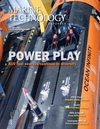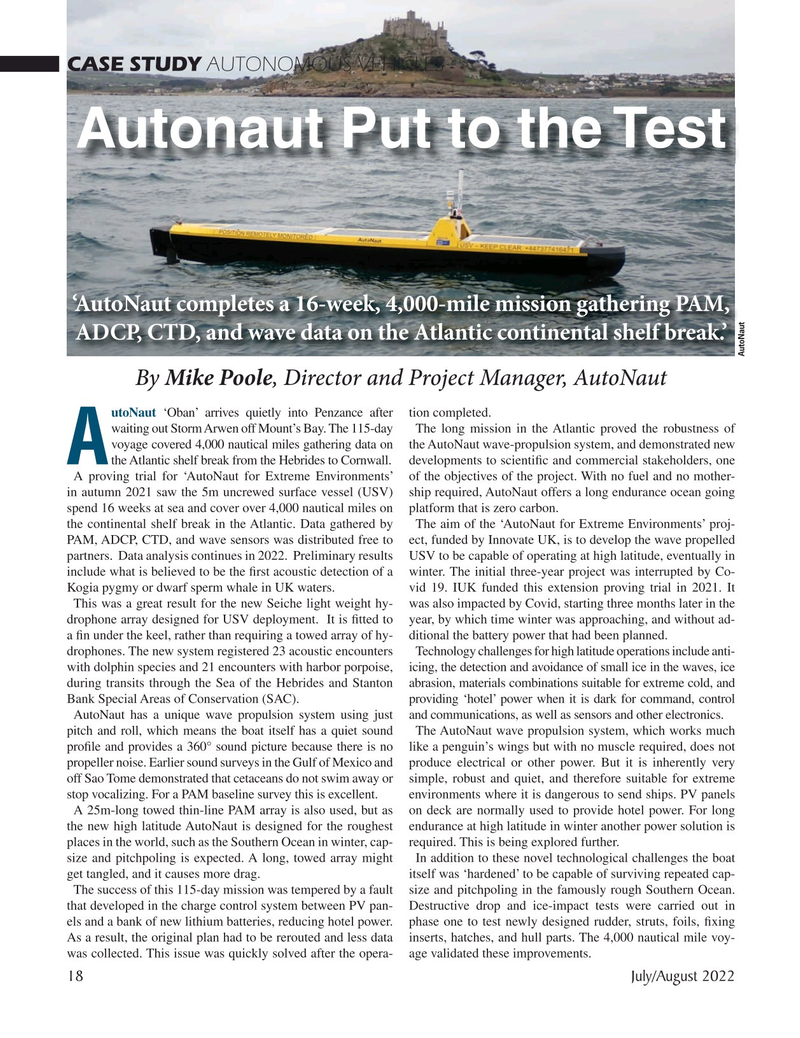
Page 18: of Marine Technology Magazine (July 2022)
Read this page in Pdf, Flash or Html5 edition of July 2022 Marine Technology Magazine
CASE STUDY AUTONOMOUS VEHICLES
Autonaut Put to the Test ‘AutoNaut completes a 16-week, 4,000-mile mission gathering PAM,
ADCP, CTD, and wave data on the Atlantic continental shelf break.’
AutoNaut
By Mike Poole, Director and Project Manager, AutoNaut utoNaut ‘Oban’ arrives quietly into Penzance after tion completed. waiting out Storm Arwen off Mount’s Bay. The 115-day The long mission in the Atlantic proved the robustness of voyage covered 4,000 nautical miles gathering data on the AutoNaut wave-propulsion system, and demonstrated new
A the Atlantic shelf break from the Hebrides to Cornwall. developments to scienti? c and commercial stakeholders, one
A proving trial for ‘AutoNaut for Extreme Environments’ of the objectives of the project. With no fuel and no mother- in autumn 2021 saw the 5m uncrewed surface vessel (USV) ship required, AutoNaut offers a long endurance ocean going spend 16 weeks at sea and cover over 4,000 nautical miles on platform that is zero carbon. the continental shelf break in the Atlantic. Data gathered by The aim of the ‘AutoNaut for Extreme Environments’ proj-
PAM, ADCP, CTD, and wave sensors was distributed free to ect, funded by Innovate UK, is to develop the wave propelled partners. Data analysis continues in 2022. Preliminary results USV to be capable of operating at high latitude, eventually in include what is believed to be the ? rst acoustic detection of a winter. The initial three-year project was interrupted by Co-
Kogia pygmy or dwarf sperm whale in UK waters. vid 19. IUK funded this extension proving trial in 2021. It
This was a great result for the new Seiche light weight hy- was also impacted by Covid, starting three months later in the drophone array designed for USV deployment. It is ? tted to year, by which time winter was approaching, and without ad- a ? n under the keel, rather than requiring a towed array of hy- ditional the battery power that had been planned. drophones. The new system registered 23 acoustic encounters Technology challenges for high latitude operations include anti- with dolphin species and 21 encounters with harbor porpoise, icing, the detection and avoidance of small ice in the waves, ice during transits through the Sea of the Hebrides and Stanton abrasion, materials combinations suitable for extreme cold, and
Bank Special Areas of Conservation (SAC). providing ‘hotel’ power when it is dark for command, control
AutoNaut has a unique wave propulsion system using just and communications, as well as sensors and other electronics. pitch and roll, which means the boat itself has a quiet sound The AutoNaut wave propulsion system, which works much pro? le and provides a 360° sound picture because there is no like a penguin’s wings but with no muscle required, does not propeller noise. Earlier sound surveys in the Gulf of Mexico and produce electrical or other power. But it is inherently very off Sao Tome demonstrated that cetaceans do not swim away or simple, robust and quiet, and therefore suitable for extreme stop vocalizing. For a PAM baseline survey this is excellent. environments where it is dangerous to send ships. PV panels
A 25m-long towed thin-line PAM array is also used, but as on deck are normally used to provide hotel power. For long the new high latitude AutoNaut is designed for the roughest endurance at high latitude in winter another power solution is places in the world, such as the Southern Ocean in winter, cap- required. This is being explored further.
size and pitchpoling is expected. A long, towed array might In addition to these novel technological challenges the boat get tangled, and it causes more drag. itself was ‘hardened’ to be capable of surviving repeated cap-
The success of this 115-day mission was tempered by a fault size and pitchpoling in the famously rough Southern Ocean. that developed in the charge control system between PV pan- Destructive drop and ice-impact tests were carried out in els and a bank of new lithium batteries, reducing hotel power. phase one to test newly designed rudder, struts, foils, ? xing
As a result, the original plan had to be rerouted and less data inserts, hatches, and hull parts. The 4,000 nautical mile voy- was collected. This issue was quickly solved after the opera- age validated these improvements.
18 July/August 2022
MTR #5 (18-33).indd 18 6/30/2022 12:51:09 PM

 17
17

 19
19
